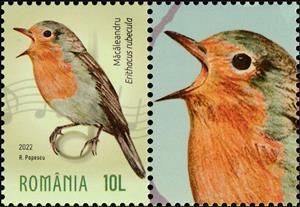Stamp with Attached Label: European Robin (Erithacus rubecula) (Romania 2022)
European Robin (Erithacus rubecula) (Romania 2022)
28 October (Romania ) within release Songbirds (2022) goes into circulation Stamp with Attached Label European Robin (Erithacus rubecula) face value 10 Romanian leu
| Stamp with Attached Label European Robin (Erithacus rubecula) in catalogues | |
|---|---|
| Romfilatelia: | Rom: RO 2391(3)SLI |
| Colnect codes: | Col: RO 2022.10.28-03b |
Stamp with Attached Label is horizontal format.
Also in the issue Songbirds (2022):
- Stamp with Attached Label - Chaffinch (Fringilla coelebs) face value 6.50;
- Stamp with Attached Label - Chaffinch (Fringilla coelebs) face value 6.50;
- Tete-Beche - Chaffinch (Fringilla coelebs) face value 2*6.50;
- Tete-Beche - Chaffinch (Fringilla coelebs) face value 2*6.50;
- Stamp with Attached Label - Eurasian Golden Oriole (Oriolus oriolus) face value 10.50;
- Stamp with Attached Label - Eurasian Golden Oriole (Oriolus oriolus) face value 10.50;
- Tete-Beche - Eurasian Golden Oriole (Oriolus oriolus) face value 2*10.50;
- Tete-Beche - Eurasian Golden Oriole (Oriolus oriolus) face value 2*10.50;
- Stamp with Attached Label - European Robin (Erithacus rubecula) face value 10;
- Stamp with Attached Label - European Robin (Erithacus rubecula) face value 10;
- Tete-Beche - European Robin (Erithacus rubecula) face value 2*10;
- Tete-Beche - European Robin (Erithacus rubecula) face value 2*10;
- Stamp with Attached Label - Nightingale (Luscinia megarhynchos) face value 3;
- Stamp with Attached Label - Nightingale (Luscinia megarhynchos) face value 3;
- Tete-Beche - Nightingale (Luscinia megarhynchos) face value 2*3;
- Tete-Beche - Nightingale (Luscinia megarhynchos) face value 2*3;
Stamp with Attached Label European Robin (Erithacus rubecula) it reflects the thematic directions:
Animals are multicellular, eukaryotic organisms of the kingdom Animalia (also called Metazoa). All animals are motile, meaning they can move spontaneously and independently, at some point in their lives. Their body plan eventually becomes fixed as they develop, although some undergo a process of metamorphosis later on in their lives. All animals are heterotrophs: they must ingest other organisms or their products for sustenance.
Birds (Aves), a subgroup of Reptiles, are the last living examples of Dinosaurs. They are a group of endothermic vertebrates, characterised by feathers, toothless beaked jaws, the laying of hard-shelled eggs, a high metabolic rate, a four-chambered heart, and a strong yet lightweight skeleton. Birds live worldwide and range in size from the 5 cm (2 in) bee hummingbird to the 2.75 m (9 ft) ostrich. They rank as the class of tetrapods with the most living species, at approximately ten thousand, with more than half of these being passerines, sometimes known as perching birds. Birds are the closest living relatives of crocodilians.
Music is an art form and cultural activity whose medium is sound organized in time. The common elements of music are pitch (which governs melody and harmony), rhythm (and its associated concepts tempo, meter, and articulation), dynamics (loudness and softness), and the sonic qualities of timbre and texture (which are sometimes termed the "color" of a musical sound). Different styles or types of music may emphasize, de-emphasize or omit some of these elements. Music is performed with a vast range of instruments and vocal techniques ranging from singing to rapping; there are solely instrumental pieces, solely vocal pieces (such as songs without instrumental accompaniment) and pieces that combine singing and instruments. The word derives from Greek μουσική (mousike; "art of the Muses"). In its most general form, the activities describing music as an art form or cultural activity include the creation of works of music (songs, tunes, symphonies, and so on), the criticism of music, the study of the history of music, and the aesthetic examination of music. Ancient Greek and Indian philosophers defined music as tones ordered horizontally as melodies and vertically as harmonies. Common sayings such as "the harmony of the spheres" and "it is music to my ears" point to the notion that music is often ordered and pleasant to listen to.



